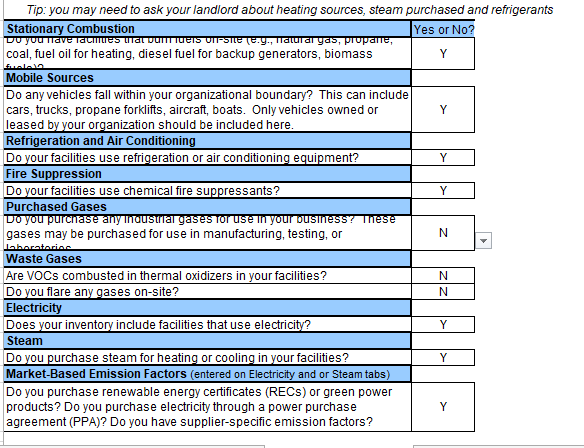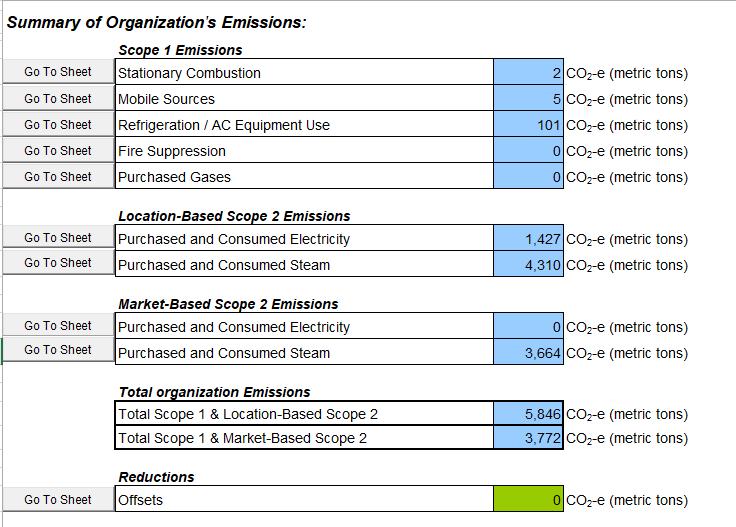How to Use the EPA’s Simplified Greenhouse Gas Emissions Calculator

The EPA’s Simplified Greenhouse Gas Emissions Calculator is a tool that allows small businesses to track their annual carbon emissions. Three steps are essential for completing the greenhouse gases inventory: defining and determining the emissions sources, collecting emission data, and quantifying and calculating the total emissions. This guide is going to explain how to use the EPA’s Simplified GHG Emissions Calculator, showcase Phipps Conservatory’s and Mt. Cuba’s scope 1 and 2 emissions, difficulties experienced during the audit and further advice about completing the guide.
Phipps completed the emissions audit for the 2019 year and Mt. Cuba completed the emissions audit for 2018.
Greenhouse gas emissions are typically categorized into three scopes. Scope 1, also called direct emissions, are those that occur from sources that are controlled or owned by the organization. Scope 1 includes stationary combustion sources, mobile sources, refrigeration/AC equipment use, fire suppression, and purchased gases. Typical scope 1 emissions may be fuel for generators and equipment, as well as vehicle fleets.
Scope 2, or indirect emissions, are greenhouse gases associated with the purchase of electricity, steam, heat, or cooling.
Scope 3 are also considered indirect emissions. These are emissions resulting from activities not controlled or owned but the organization but occur because of it. Scope 3 includes emissions associated with employee travel and commuting as well as product transport. Phipps and Mt. Cuba completed Scope 1 and 2 emissions for their audits but plan to add Scope 3 going forward.
Value of Benchmarking
Before reducing your emissions, the first thing you need to do is to understand your operations and from where your emissions are originating. One way to do this is to create a baseline of emissions. Once you have this, it can serve as a benchmark helping you observe changes over time, such as increases or decreases in energy demand. A benchmark can also help you identify reasonable and achievable targets for your emissions reduction strategies.
Defining Your Emission
The first section of the calculator, Boundary Questions, asks you to define the carbon emission sources by answering a series of questions. A “yes” response to a boundary question indicates you do have emissions from that source and you will complete the associated tab. A “no” response indicates you do not have emissions from that source and you will skip the associated tab.
Listed below are the Phipps’ answers to the Boundary Questions for Scope 1 and 2 emissions.

Collecting Emission Data — Scope One Calculations
You are now ready to begin entering data for each of the sources as defined in the boundary questions. As you enter data, the total greenhouse gas emissions associated with that source will appear at the bottom of that page as well as on the summary page. These figures will automatically update every time you enter or change data. If you have any issues or questions, the calculator includes a help section for each emission source.
The first source in the calculator is Stationary Combustion . These are emissions from fuel combusted by stationary sources that are on site. Fuels include are coal, fuel oil, kerosene, propane, natural gas, wood and others. There are fields for you to enter the type and amount of fuel combusted and the tool will calculate the associated emissions.
Below is Phipps’ Stationary Source Fuel Combustion. Phipps totaled the amounts and entered each fuel as a single line item. Alternatively, you can record each piece of equipment or building individually as Mt. Cuba did below.

Mt. Cuba’s Stationary Fuel Combustion calculations.

The next set of scope 1 emissions to calculate are Mobile Sources. These include emissions associated with cars, trucks, tractors or other vehicles that are owned or leased by the organization. The vehicle type and fuel usage or miles travelled can be entered.
Below are Phipps’ mobile sources. Note that diesel- or gas-powered tools like chainsaws and mowers are captured here.

Mt. Cuba’s Mobile Sources are listed below. Mt. Cuba has over 40 vehicles in their fleet. Here they entered the vehicle types and total fuel usage. Classify each of the gas-powered equipment under Other Off road Equipment.

Refrigeration and Air Conditioning Equipment is the next emission source. Refrigerants can be very potent greenhouse gases, so it is important to account for any leakage or replacement of them in your audit. There are three different methods from which to choose to calculate these data.
- If you maintain your own equipment, please use option 1. The first option is a material balance method where you calculate the gas stored and transferred by the facility. You will have to enter the gas, difference of the gas stored in inventory, gas purchased, and the gas sold, and the capacity of all units.
- If contractors service your equipment, use option 2. You have to report the gas, installments during the reporting period, gas added by a contractor or company, sum of the capacity for all units, and the total gases recovered. Values for any added gases should be on invoices from the servicing agent.
- Option 3 is a screening method that is only a tool and is highly uncertain. It is not recommended to use this to calculate your emissions.

Fire Suppression Equipment can emit chemicals during use, maintenance, and disposal. Fire Suppressant purchase, inventory, and disposal data, inventory of equipment by facility, fire suppressant capacity, and the amount of the fire suppressant emitted are needed to complete one of the three methodologies to calculate the emissions. You only have to record equipment which is changed, any gas that is transferred, discharged or leaked. Neither Phipps nor Mt. Cuba had any Fire Suppression Equipment emissions.
The next emissions source is Purchased Gases. Most gases are used in manufacturing, testing, or laboratory uses but any other the seven major greenhouse gases used (CO2, CH4, N2O, PFCs, HFCs, SF6, and NF3) need to be recorded on this page. You will need to record the type of gas, the amount of gas, and the purpose of the gas. Neither Phipps nor Mt. Cuba had any emissions from purchased gases.
The final Scope 1 source is Waste Gases. These include emissions that are created in combustion flare or thermal oxidizer and are uncommon in most settings. Neither Phipps Conservatory nor Mt. Cuba had any waste gas emissions.
Fire Suppression Equipment can emit chemicals during use, maintenance, and disposal. Fire Suppressant purchase, inventory, and disposal data, inventory of equipment by facility, fire suppressant capacity, and the amount of the fire suppressant emitted are needed to complete one of the three methodologies to calculate the emissions. You only have to record equipment which is changed, any gas that is transferred, discharged or leaked. Neither Phipps nor Mt. Cuba had any Fire Suppression Equipment emissions.
The next emissions source is Purchased Gases. Most gases are used in manufacturing, testing, or laboratory uses but any other the seven major greenhouse gases used (CO2, CH4, N2O, PFCs, HFCs, SF6, and NF3) need to be recorded on this page. You will need to record the type of gas, the amount of gas, and the purpose of the gas. Neither Phipps nor Mt. Cuba had any emissions from purchased gases.
The final Scope 1 source is Waste Gases. These include emissions that are created in combustion flare or thermal oxidizer and are uncommon in most settings. Neither Phipps Conservatory nor Mt. Cuba had any waste gas emissions.
Scope 2 — Indirect Emission Calculations
Scope 2 emissions are greenhouse gases associated with the purchase of electricity, steam, heat, or cooling. Both the amount of steam and purchased electricity can be looked up within utility bills.
The first scope 2 emissions source you will calculate is Purchased Electricity. There are two methodologies for quantifying emissions from purchased electricity: location-based and market-based. Both are required to complete the section. The location-based method considers the average emission factors based on the grid that provides the electricity. The market-based method considers contractual agreements the organization may have to procure electricity, including that from renewable resources. Guidance in the tab and a separate help page provide more specific details.

The next source is the Purchased Steam. You enter the type of fuel that is used to create the steam and the amount purchased (mmBTUs). If boiler efficiency and/or emissions factor data from the plant from which you procure steam provides data about boiler efficiency and emission is available from the plant from which you procure steam, you can enter them. If not, default values are auto populated. Similar to purchased electricity, there are both location-based and market-based methodologies.
Calculating the Final Emissions
Once you have completed the guide, the summary tab will your total greenhouse gas emissions for Scopes 1 and 2. There is also a tab to include any purchased offsets, which are subtracted from you total organizational emissions.







Recent Comments